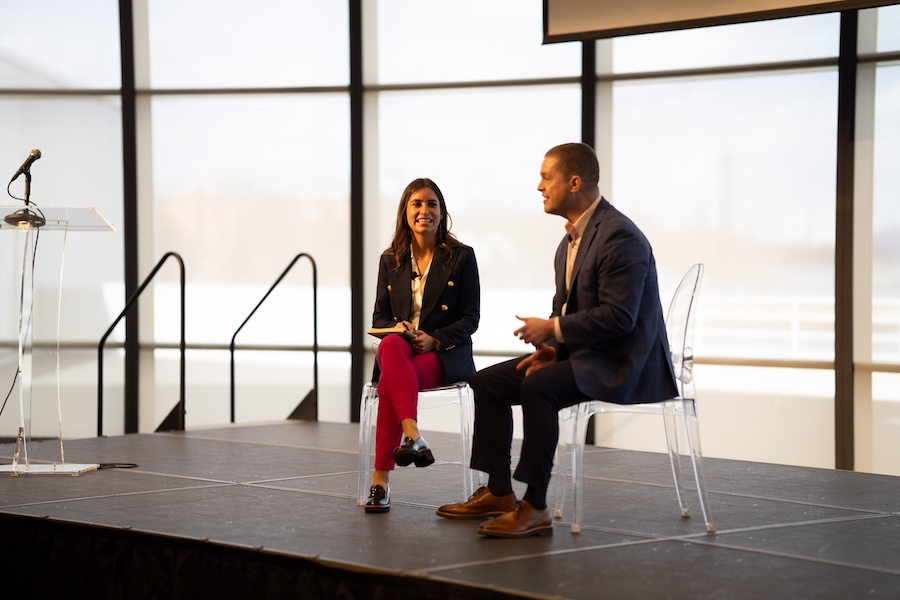Walking the Walk: Best Practices for Supporting a Mentally Well Workplace


The conversation around mental health has drastically changed in the last four years, according to the Vice President of Talent at the mental-health platform Talkspace, Kaleigh Oleynik.
Oleynik, a former middle-school teacher, asked for a show of hands from the audience: “How many of you were discussing mental health at work before the pandemic?” Some audience members raised their hands.
But when surveyed again to find out who is presently discussing mental health at work, all hands went in the air. “This is a conversation that started before the pandemic,” she said, yet its significance has grown. She traces it back to an article that appeared in Harvard Business Review, which collected quotes from Lady Gaga and Prince Harry that normalized mental health talk.
Oleynik spoke in a thought leadership spotlight with colleague Ryan Kellogg, Talkspace’s VP of partnerships & sales effectiveness at From Day One’s Boston benefits event. The speakers explored the intersection of employee well-being and crafting an organizational culture that inspires and uplifts. “What we’re very passionate about is customizing and catering through our virtual mental health options,” said Kellogg. “You really have to step inside the arena with your employees to make sure that they're digesting the information and that you’re catering to their needs.”
For instance, it’s important for a user or patient to be able to address a need in real time, potentially pairing up with a licensed therapist within hours or days. Talkspace currently has 5,000 licensed therapists across 50 different states that have a very diverse background. 40% of their therapists specialize in LGBTQ topics, 40% focus on adolescent care, and 30% of them focus on BIPOC patients or identify as BIPOC, with 35 different languages being represented.
“That’s very deliberate to ensure that if your employee is looking for mental health care, they’re being treated as the individual they are,” said Kellogg. Benefits-wise, Talkspace is focused on the continuum of care, which, other than the standard offerings in mental health, includes medication management and psychiatry.

Current areas of interest include women’s health and mental-health resources for the adolescent population. “Over the past year we’ve been very aggressive about partnering with different organizations that also focus on the well-being of their employees, so that we can leverage their network and vice versa,” said Kellogg.
At the core of Talkspace walking the walk, is their internal-communications strategy. “During times of deep change, like restructuring, layoffs, or just macro trends that are changing, we focus on communication. That is the root of psychological safety,” says Oleynik.
Communication rooted in consistency breeds safety. At Talkspace, every two weeks there is an all-hands meeting that starts the same way: a video introduction, a leader talking, and a deep dive into a specific topic. “I think that last part is actually the most important because we know when people are feeling concerned about the company or disconnected, they can start to feel powerless and a little bit like they’re operating within some sort of black box,” said Oleynik.
Oleynik also prioritizes creating a safe space for questions, even on matters that might be complicated or confusing. “We’re a public company, so we have earning calls,” Oleynik continues. “They can be technical, but I mandate that everyone listens to them and then we debrief them: I always say there are no stupid questions.”
Communication is more complex than it seems. “I’ve learned the hard way that just because I put out information, am very deliberate, look people in the eye, and have meaningful conversation, doesn't necessarily mean that they feel appreciated,” says Kellogg. It’s imperative to have conversations with everyone, and “rubbing elbows with every layer of your chain of command,” so that you can cultivate trust and ensure everyone feels seen.
And sometimes there can be disconnect, where you feel you’ve had these great conversations, but that might not be reciprocated. In this case, to create a feedback loop, Oleynik is a fan of surveys. When they surveyed their employees, “It was really helpful to see where we felt like we were doing a great job of communicating certain things” and also find the spots that could be communicated more thoroughly.
Editor’s note: From Day One thanks our partner, Talkspace, for sponsoring this thought leadership spotlight.
Angelica Frey is a writer and a translator based in Boston and Milan.
The From Day One Newsletter is a monthly roundup of articles, features, and editorials on innovative ways for companies to forge stronger relationships with their employees, customers, and communities.